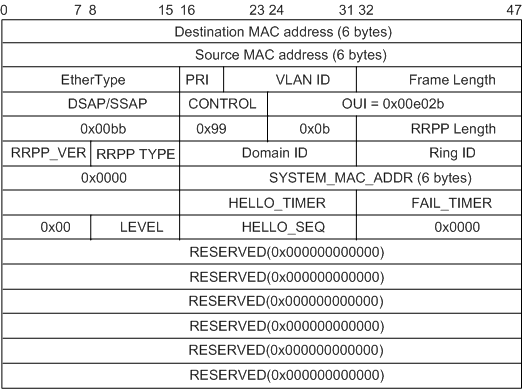RRPP Packets
Table 1 lists different types of RRPP packets.
RRPP Packet Type |
Description |
|---|---|
Hello (HEALTH) |
The master node sends Hello packets to check for loops on a network. |
LINK-DOWN |
Transit nodes, edge nodes, or assistant edge nodes send LINK-DOWN packets to notify the master node that an interface is Down. |
COMMON-FLUSH-FDB |
The master node sends COMMON-FLUSH-FDB packets to request that transit nodes, edge nodes, or assistant edge nodes update their MAC address entries, ARP entries, and ND entries. |
COMPLETE-FLUSH-FDB |
The master node sends COMPLETE-FLUSH-FDB packets to request that transit nodes, edge nodes, or assistant edge nodes update their MAC address entries, ARP entries, and ND entries, and enable transit nodes to unblock temporarily blocked interfaces to forward data packets. |
EDGE-HELLO |
The edge node sends EDGE-HELLO packets on a sub-ring and the assistant edge node on the same sub-ring receives EDGE-HELLO packets to check whether the major ring is complete in the same RRPP domain as the sub-ring. |
MAJOR-FAULT |
The assistant edge node on a sub-ring sends MAJOR-FAULT packets to notify the edge node that the major ring in the RRPP domain fails when the assistant edge node does not receive the Edge-Hello packet from the edge interface within a specified period. |
Although there are many different types of RRPP packets, they all have a very similar format. Figure 1 demonstrates the format of an RRPP packet.
Descriptions of each field in an RRPP packet are as follows:
Destination MAC address: indicates the destination MAC address of the packet. The field occupies 48 bits.
Source MAC address: indicates the source MAC address of the packet. The MAC address is the bridge MAC address. The field occupies 48 bits.
EtherType: indicates the encapsulation type. The EtherType value is fixed as 0x8100, which indicates tagged encapsulation. The field occupies 16 bits.
PRI: indicates the Class of Service (CoS) value. The PRI value is fixed as 0xe. The field occupies 4 bits.
VLAN ID: indicates the ID of the VLAN to which the packet belongs. The field occupies 12 bits.
Frame Length: indicates the length of the Ethernet frame. The Frame Length value is fixed as 0x0048. The field occupies 16 bits.
DSAP/SSAP: indicates the destination or source service access point. The DSAP/SSAP value is fixed as 0xaaaa. The field occupies 16 bits.
CONTROL: The field has no significance and occupies 8 bits. The CONTROL value is fixed as 0x03.
OUI: The field has no significance and occupies 24 bits. The OUI value is fixed as 0x00e02b.
RRPP_LENGTH: indicates the length of the RRPP data unit. The RRPP_LENGTH value is fixed as 0x0040. The field occupies 16 bits.
RRPP_VER: indicates the RRPP version. The current version is 0x01. The field occupies 8 bits.
RRPP TYPE: indicates the type of the RRPP packet. The field occupies 8 bits. The RRPP packet types and values are described as follows:
HEALTH = 0x05
COMPLETE-FLUSH-FDB = 0x06
COMMON-FLUSH-FDB = 0x07
LINK-DOWN = 0x08
EDGE-HELLO = 0x0a
MAJOR-FAULT = 0x0b
DOMAIN_ID: indicates the ID of the RRPP domain to which the packet belongs. The field occupies 16 bits.
RING_ID: indicates the ID of the RRPP ring to which the packet belongs. The field occupies 16 bits.
SYSTEM_MAC_ADDR: indicates the bridge MAC address from which the packet is sent. The field occupies 48 bits.
HELLO_TIMER: indicates the timeout period (in seconds) of the Hello timer on the node that sends the packet. The field occupies 16 bits.
FAIL_TIMER: indicates the timeout period (in seconds) of the Fail timer on the node that sends the packet. The field occupies 16 bits.
LEVEL: indicates the level of the RRPP ring to which the packet belongs. The field occupies 8 bits.
HELLO-SEQ: indicates the sequence number of the Hello packet. The field occupies 16 bits.
